{"pageProps":{"page":1,"posts":[{"date":"2022-06-08T14:30:00Z","layout":"post","title":"Escaping a paper bag","author":["Celina Bledowska"],"hero":"/static/images/pages/posts/2022-06-07-escaping-a-paper-bag/hero.jpg","tags":["NorDev","NorDevCon","2022","Interview"],"excerpt":"When machine learning and AI specialist, Fran Buontempo, approached nor(DEV):22 with her conference speech title: ‘Coding your way out of a paper bag,’ we were puzzled. Was this some esoteric philosophical thesis, or would the keynote speech really explain how to code out of a pa...","body":"\nWhen machine learning and AI specialist, Fran Buontempo, approached nor(DEV):22 with her conference speech title: ‘Coding your way out of a paper bag,’ we were puzzled. Was this some esoteric philosophical thesis, or would the keynote speech really explain how to code out of a paper bag? \n\n## Out of hand project\n\nFran Buontempo heads up her own [consultancy](https://about.me/frances_buontempo) where she works as a development dev ops contractor for investment banks in London, specialising in modelling and has a PhD in machine learning. When asked about her paper bag conundrum, Fran explained:\n\n> Tt comes from the phrase that came to me after interviewing an unsuccessful job candidate, ‘that guy couldn’t code their way out of a paper bag.’\n\nThis set her thinking and Fran realised she didn’t know how to use code to escape a bag. Therefore, the question of how to carry out this task saw the light of day. Is this possible or not? \n\n## The task\n\n“You can model a paper bag with a square or a rectangle and then you want something inside it that moves and will end up outside the bag. You could completely over-engineer this with machine learning tools and algorithms or you could run a simulation or diffusion. Flecks or dots can start in the middle and then gradually spread out.” \n\nFran suggests that the audience thinks of a gas moving within a gas model that will only require some adding up (computer led task), or orange squash diffusing once water is added to the squash is another way of understanding the problem.\n\nBy using this model, Fran suggests that this is a simplified way of explaining and learning more complicated ideas..\n\n## Machine learning\n\nFran is looking forward to giving the conference a “walkthrough of genetic algorithms and how these can be used to escape the ubiquitous bag.” She explains a genetic algorithm as, “using the idea of genetics as an algorithm rather than biology, a ‘nature inspired algorithm,’and Darwinian evolution in order to evolve a solution for something.” “All you actually do,” Fran continued, “is try with random attempts, as carrying out numerous permutations would be too time consuming, and then I’ll be able to deduce which ones are better, and this will give you more to experiment with.” She added, “through numerous experiments you will be able to prove your premise.”\n\n> In short you’ll be trying stuff, keeping track of what you’ve done and making things improve.\n\n## Experimenting and science\n\nIn an attempt to understand how things actually work, Fran codes from scratch. For example, the pandemic threw up numerous problems where machine learning was used to find an answer.and she believes that if you’re trying to model Covid and trying to work out what type of things might stop the spread, you could take a pre-built mathematical model and send in some parameters and numbers, and lots of libraries will do things for you. This is the methodology applied by most data scientists. But Fran is keen to add that you can build things yourself. \n\nMany people use Python in this field as there are many Python libraries that let you click together pre-existing pieces. Fran uses Python too but is happy to switch to C++ and other languages.\n\nBack to that paper bag. To find out how you can code your way out of this receptacle, you can catch [Fran’s keynote speech at 16.15 on 16 June](https://nor.dev/con). \n\n\n","path":"/posts/2022-06-07-escaping-a-paper-bag"},{"date":"2022-05-31T14:30:00Z","layout":"post","title":"Migrating toilets","author":["Celina Bledowska"],"hero":"/static/images/pages/posts/2022-05-31-migrating-toilets/hero.jpg","tags":["NorDev","NorDevCon","2022","Interview","Open Source"],"excerpt":"Developer at The Guardian and open source aficionado, Oliver Barnwell, has invested a fair amount of time in a unique project, the Great British Toilet Map. Billed as ‘the largest database of publicly accessible toilets’ in the UK - no one need ever get caught short again. Lookin...","body":"\nDeveloper at The Guardian and open source aficionado, Oliver Barnwell, has invested a fair amount of time in a unique project, [the Great British Toilet Map](https://www.toiletmap.org.uk/). Billed as ‘the largest database of publicly accessible toilets’ in the UK - no one need ever get caught short again. Looking for an all important public lavatory anywhere is easy with this tool.\n\n## Early beginnings\n\nOliver started coding at a young age, joining a [Neontribe](https://www.neontribe.co.uk/the-tribe/) led centre run by Rupert Redington & Harry Harrold as part of the national hackathon: Young Rewired State. For every summer, until he was 18, Oliver attended this and other events, and the experience enabled him to work at the company during his gap year. It was during this time that he started working on Neontribe’s [Toilet Map](https://github.com/neontribe) as an open source project, with Rupert and design researcher, the Royal College’s, Gail Ramster, who was collecting data for toilet locations. Exploring the search behaviour on the [Toilet Map Explorer](https://www.toiletmap.org.uk/explorer) was Oliver’s one of many projects during this gap year.\n\n## Migrating a project\n\nAfter graduation and having started a new job at Investec and before moving on to The Guardian,where he has worked on the newspaper’s identity platform migration. Oliver continues to contribute to the [Great British Public Toilet Map](https://www.toiletmap.org.uk/) This open source project is dedicated to helping people find toilets across the UK. In any city, in any part of the UK, simply click on the map and you’ll find your much needed facility.\n\nHaving retained his passion for the toilet mapping project, Oliver is working on the next stage. In 2021 the project started its migration from a Single Page Application (SPA) React app to using Next.js and TypeScript. The core aim for the migration was to improve the user experience and to improve the onboarding process for any community contributors. As the app was an SPA, those on the move can find it on their mobile browser.\n\nDuring June the migration will be released to all users and changes will be rolled back if necessary.\n\n## Looking for a loo\n\nMapping the UK’s numerous public toilets performs a valuable role for social historians, an important project for developers and an invaluable function for those of us that desperately need a loo when out and about\n\nNeon Tribe is an integral part of the project, as Oliver says, “ it’s been ten years in the making and I’ve only played a very small part, Rupert is the instigator along with Gail.”\n\nThe Great British Toilet Map may shortly become a global map. Rupert has confirmed: \"I think it is fine to say that we're laying the foundations for use in other countries and cultures.\"\n\nCatch up with Oliver’s talk on 16 June or [contribute to the project](https://github.com/neontribe/gbptm).\n\n\n","path":"/posts/2022-05-31-migrating-toilets"},{"date":"2022-05-29T12:00:00Z","layout":"post","title":"Make The Dead Fish Swim - Test Driven Golang","author":["Damien Sedgwick"],"tags":["Golang","Go","TDD","Test Driven Development","Coding Challenge"],"excerpt":"Today we are going to take a look at solving \"Make The Dead Fish Swim\" - A Codewars challenge ranked '6 kyu' and we are going to do it using Test Driven Development. First of all, let us look at the challenge we are going to tackle: Write a simple parser that will parse and run D...","body":"\nToday we are going to take a look at solving \"Make The Dead Fish Swim\" - A Codewars challenge ranked '6 kyu' and we are going to do it using Test Driven Development.\n\nFirst of all, let us look at the challenge we are going to tackle:\n\n```go\nWrite a simple parser that will parse and run Deadfish.\n\nDeadfish has 4 commands, each 1 character long:\n\n i increments the value (initially 0)\n d decrements the value\n s squares the value\n o outputs the value into the return array\n\nInvalid characters should be ignored.\n\nParse(\"iiisdoso\") == []int{8, 64} // example output\n```\n\nA quick disclaimer, there is a good chance that there is a very concise and clever solution to this challenge, and I will share it at the end of this post. However my goal here is to practice taking a problem, and breaking it down into small testable pieces of functionality that could be used elsewhere (if we were building something in real life).\n\nWe are going to be working in two different files, main.go and main_test.go\n\nI will also be using a package that I like to use when writing tests and that package is https://github.com/stretchr/testify\n\nFor me, a good starting point is to write out some test functions for the bits of the challenge that are repeated throughout the program, increment one, decrement one, square and outputs to the array. Although for now, I will start with the first three.\n\n```go\nfunc TestIncrementOne(t *testing.T) {\n\tassert.Equal(t, 1, IncrementOne(0))\n\tassert.Equal(t, 5, IncrementOne(4))\n\tassert.Equal(t, 100, IncrementOne(99))\n}\n\nfunc TestDecrementOne(t *testing.T) {\n\tassert.Equal(t, 0, DecrementOne(1))\n\tassert.Equal(t, 4, DecrementOne(5))\n\tassert.Equal(t, 99, DecrementOne(100))\n}\n\nfunc TestSquare(t *testing.T) {\n\tassert.Equal(t, 1, Square(1))\n\tassert.Equal(t, 25, Square(5))\n\tassert.Equal(t, 64, Square(8))\n}\n```\n\nEach of these functions will provide us with a specific piece of functionality that we will later need when parsing the input for the challenge. Let us run the tests.\n\n```go\n// go test\n\n./main_test.go:23:21: undefined: IncrementOne\n./main_test.go:27:21: undefined DecrementOne\n./main_test.go:31:21: undefined: Square\nFAIL github.com/damiensedgwick/codewars/makeTheDeadFishSwim [build failed]\n```\n\nPretty simple, they all fail because none of the functions actually exist yet, so let us create them.\n\n```go\nfunc IncrementOne(n int) int {\n\treturn n + 1\n}\n\nfunc DecrementOne(n int) int {\n\treturn n - 1\n}\n\nfunc Square(n int) int {\n\treturn n * n\n}\n```\n\nThese functions are very simple and may seem in fact trivial however they are going to give us the foundations we need to solve the challenge. \n\nLet us run the tests again.\n\n```go\n// go test\n\nPASS\nok github.com/damiensedgwick/codewars/makeTheDeadFishSwim 0.195s\n```\n\nMuch better, so what is next.\n\nI think a good step would be to take the input string we are going to receive, and turn it in to an array of strings so that we can loop through it and decide what we would like to happen for each element of that array.\n\nThe test\n\n```go\nfunc TestSplitString(t *testing.T) {\n\tassert.Equal(t, []string{\n\t\t\"i\",\n\t\t\"i\",\n\t\t\"i\",\n\t\t\"s\",\n\t\t\"d\",\n\t\t\"o\",\n\t\t\"s\",\n\t\t\"o\",\n\t}, SplitString(\"iiisdoso\"))\n}\n```\n\nIf we run `go test` it will fail because this function does not yet exist, so let us create it.\n\n```go\nfunc SplitString(s string) []string {\n\treturn strings.Split(s, \"\")\n}\n```\n\nNow our tests are happy again, we can proceed to the next step which could in fact be parsing the input. Let us write a test and see how we get on.\n\n```go\nfunc TestParse(t *testing.T) {\n\tassert.Equal(t, []int{8, 64}, Parse(\"iiisdoso\"))\n}\n```\n\nThe challenge is kind enough to give us a test case so we have used that to write the test and now we can try to create the function and make the test pass.\n\n```go\nfunc Parse(input string) []int {\n\tvar output = []int{}\n\n\tcount := 0\n\n\ts := SplitString(input)\n\tfor _, v := range s {\n\t\tswitch v {\n\t\tcase \"i\":\n\t\t\tcount = IncrementOne(count)\n\t\tcase \"d\":\n\t\t\tcount = DecrementOne(count)\n\t\tcase \"s\":\n\t\t\tcount = Square(count)\n\t\tcase \"o\":\n\t\t\toutput = append(output, count)\n\t\tdefault:\n\t\t\tcontinue\n\t\t}\n\t}\n\n\treturn output\n}\n```\n\nSo now we have our parse function, we can run the tests again and they should all be happy.\n\nThe tests are happy so I am going to take my code and paste it in to the codewars challenge, making sure to tweak variables names I used for the ones they specified and importing any packages that I used.\n\nLet us take a look at the results\n\n```go\nTest Results:\nRandom tests\nrandom test #1 (`ossrshsbzotsdkpvuisekvcci`)\nrandom test #2 (`odzosiqdshbiikiisiiyigdlzyd`)\nrandom test #3 (`sokssndofoimuqbqipsedfodticuotosdso`)\nrandom test #4 (`siiooisdisijoilusdshqddzosiotdoio`)\nrandom test #5 (`oiiswwmaisdosisooitio`)\nrandom test #6 (`sdhhidyoioimsoidioooodsiddoio`)\n...\nrandom test #94 (`dssdbiddoskuoondgirikdeuolspdjtsjkisido`)\nrandom test #95 (`rsoboobssixzzoudfiinbddgm`)\nrandom test #96 (`iooeioyoyviwsoqsisdhaixxl`)\nrandom test #97 (`idsdodsfsdbxdismiskdsis`)\nrandom test #98 (`icdzdsissuigoijvopdddpiddgsw`)\nrandom test #99 (`diioidooooisssmdiiisiiosossiiohivvowud`)\nrandom test #100 (`odooszoatitdwdibkdko`)\n```\n\nAll test cases have passed and the challenge is complete! Now as mentioned, there is probably a very short and concise answer to this challenge which I will share below however I hope this post has given you an insight to how powerful test driven development can be.\n\n```go\npackage kata\n\nfunc Parse(data string) []int{\n output := []int{}\n var val int\n for _, s := range data {\n switch string(s) {\n case \"i\":\n val++\n case \"d\":\n val--\n case \"s\":\n val = val * val\n case \"o\":\n output = append(output, val)\n }\n }\n \n return output\n}\n```\n\nSo in fact the solution is very similar to the one we implemented in this post. The only difference is we have the backing of our tests to give us absolute confidence in our programs functionality.","path":"/posts/2022-05-29-tdd-go-make-the-dead-fish-swim"},{"date":"2022-05-27T14:30:00Z","layout":"post","title":"Driving culture change","author":["Celina Bledowska"],"hero":"/static/images/pages/posts/2022-05-27-driving-culture-change/hero.jpg","tags":["NorDev","NorDevCon","2022","Interview"],"excerpt":"When Ben Frost first joined Bourne Leisure as Head of Product, he soon realised that getting users’ opinions was paramount. Bourne are the owners of Haven Holidays. Here he explains how he implemented a system that involved both users and devs. First discoveries Coming from the T...","body":"\nWhen [Ben Frost](https://www.linkedin.com/in/benfrostproduct/) first joined [Bourne Leisure](https://bournecareers.co.uk/) as Head of Product, he soon realised that getting users’ opinions was paramount. Bourne are the owners of Haven Holidays. Here he explains how he implemented a system that involved both users and devs.\n\n## First discoveries\n\nComing from the Times Educational Supplement, (TES) and with a successful business background behind him, Ben arrived at Bourne Leisure seeking a challenge. He started at Bourne right before lockdown - just as the hospitality industry was about to shut down. It became obvious that the “company culture needed to change as well as the tech. The tech was so archaic and so vast, and this revealed that the culture had to change, so that’s what I focussed on.”\n\n## Solving a problem\n\n‘Historically, Bourne had never had an ‘in house’ digital or website software team. They did have a couple of IT engineers and Project Managers, though these acted as conduits between agencies and the company.” This short-term approach resulted in countless website add-ons and no cohesive strategy.\n\nTo find a solution, Ben focussed more on identifying the problem, and one of the first issues he addressed was to actually ask holiday homeowners what their experience on a daily basis was. To accumulate this data in a business that wasn’t data driven, was difficult. For example, even Google analytics hadn’t been set up correctly. The figures were all wrong and this was something Ben realised he had to rectify.\n\n## Building a business without data\n\nBy getting out there and talking to holiday homeowners, Ben started from scratch. Calls were set up with holiday homeowners by Ben’s team - this was all taking place during the pandemic. As a result of these calls one of the first changes implemented was to allow holiday homeowners to submit their insurance certificates online - previously this function had been carried out manually. This was the start of the dev team building “feature after feature to replace these manual processes”\n\n## Facing challenges.\n\nBen is one of the people who can say that he had “a helping hand with the pandemic.” This gave him time to approach Haven, demonstrate the new features, and then continue to implement “more complex stuff.” The business realised that there was a complete lack of alternatives and by focussing on the basics, Ben was able to solve problems for the holiday homeowners, and therefore Haven. He was also able to demonstrate that the smartphone generation isn’t simply in their 20s and there was a need for company-wide tech modernisation.\n\n## Tech innovations\n\nBy starting from “ground zero,” Ben joined the new digital team when they were able to all fit in a small office of 8 called ‘the cupboard’, this has now expanded to over 100 team members all over the world working remotely. Outsourcing is a thing of the past, it’s more cost effective for the company and has proven that the team can create products to match both the company’s and holiday homeowners’ needs. Historically, everything had been built on Prem. This hadn’t changed since the 1990s, now nearly every bit of Prem has been moved into AWS.\n\nTrying to implement a single view of the customer base is on Ben’s future wish list. This will be the biggest change that the business will implement. Previously, Haven had not been able to experience the ‘art of the possible’ - the in-house tech team makes creative change a probability.\n\n\n","path":"/posts/2022-05-27-driving-culture-change"},{"date":"2022-05-23T08:00:00Z","layout":"post","title":"Product Hunt Kitty comes to Norwich!","author":["Juliana Meyer"],"tags":["NorDev","Product Hunt"],"excerpt":"Norwich startup SupaPass launches on Product Hunt today, so this Kitty doesn’t need to lift a paw! Hey, I’m the Product Hunt Kitty. You may recognise me from the Golden Kitty Awards, won by innovators like Elon Musk. I love prowling around hunting tech products and mice, and oth...","body":"\n_Norwich startup [SupaPass](https://www.supapass.com) launches on Product Hunt today, so this Kitty doesn’t need to lift a paw! _\n\nHey, I’m the [Product Hunt Kitty](https://producthuntkitty.supapass.io). You may recognise me from the Golden Kitty Awards, won by innovators like Elon Musk. \n\nI love prowling around hunting tech products and mice, and other fun stuff. I’m an influencer cat so I have lots of friends who like to hunt products too. Anyone can be a Hunter, but some Hunters have discovered thousands of disruptive products!\n\nFor example, [Chris Messina is the #1 Hunter](https://www.producthunt.com/@chrismessina). You may know Chris as the guy that [invented the Hashtag](https://tedxbend.com/presenters/chris-messina/)! He’s hunted over 3,000 amazing products, so 34,000 product hunters follow what he posts. \n\nToday [Chris has hunted SupaPass](https://www.producthunt.com/posts/supapass). \n\nWhen I heard what they make, I had to have it! …so the team at SupaPass made me The Pawsome App! \n\n\n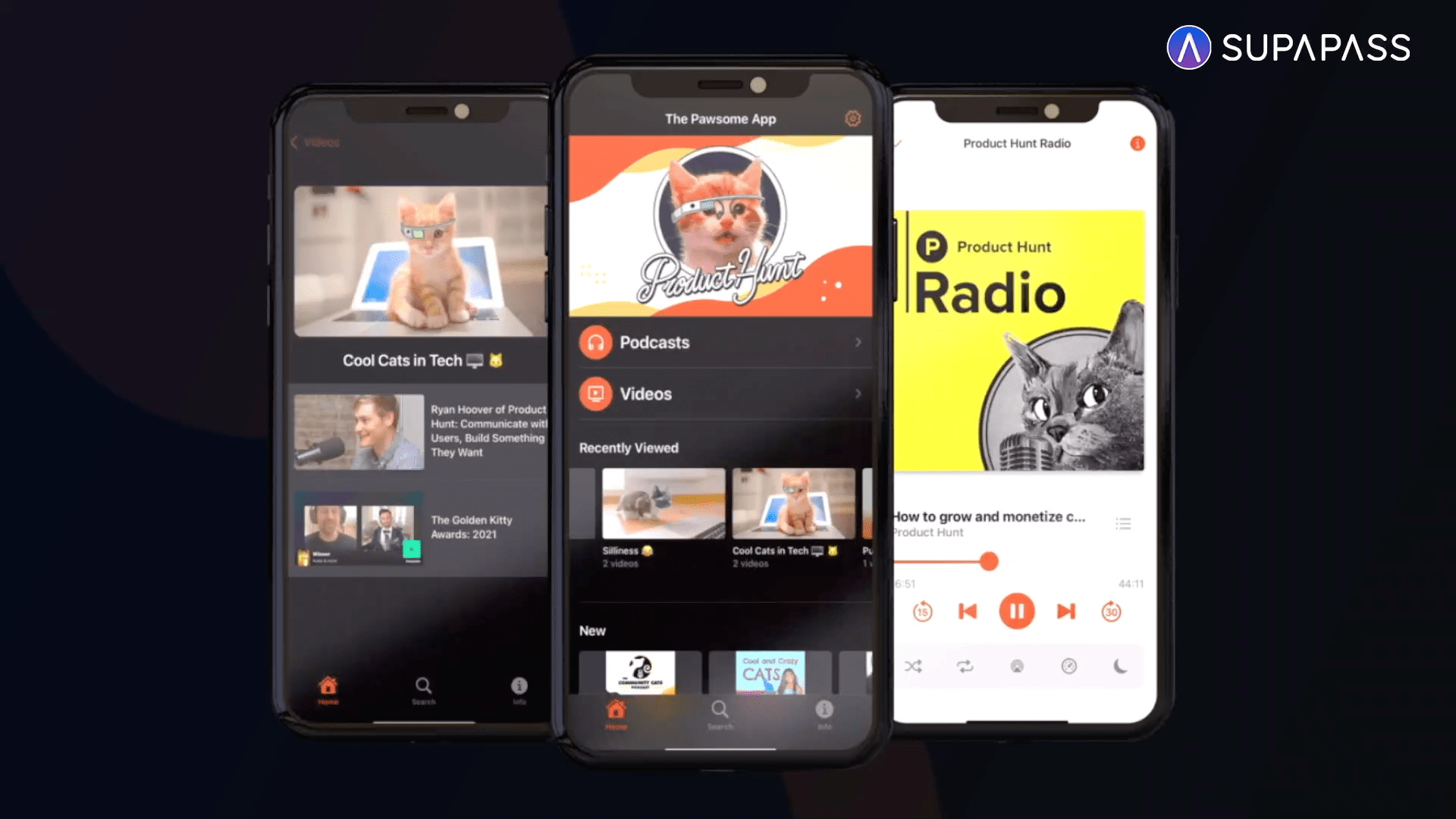\n\n\nNow I’m stepping it up with [my own website and app](https://producthuntkitty.supapass.io) where you can find my favourite [Product Hunt podcasts](https://producthuntkitty.supapass.io/audio), [Golden Kitty Awards](https://producthuntkitty.supapass.io/collection/7539), and other cat videos and pod-cats.\n\nIt’s purr-fect for writing comments - humans and cat paws welcome - in my Kitty community.\n\nI now don't have to lift a paw because being a content creator is so much easier. I get to focus on what really matters to me: sleeping in the sun and eating fish.\n\nDownload my Pawsome App and [come say hello](https://producthuntkitty.supapass.io) to other kitties and product hunters that love this Kitty!\n\nIt was so easy to make that _even my paws_ could get the App created and published to the App Stores within 24 hours, with the SupaPass Product!\n\nIt is purr-fect for me, and I wanted to know more about the SupaPass team, so I went hunting. \n\n\n\n\n\nWhen I heard that SupaPass is from Norwich, I came down here to see what other cool tech the NorDev Community is making… I love prowling around new neighborhoods, meeting other cats, and hunting. So if there’s any products lurking here I’ve not seen yet, come join me on Product Hunt so I can share it with all my friends. Meows on the street tell me you can ask your friends at [SupaPass](https://www.supapass.com) who’ll be happy to share all the things they learnt preparing for their [SupaPass Product Hunt Launch](https://www.producthunt.com/posts/supapass)\n\nProduct Hunt is a curation of the best new products, every day. It’s the best place to discover new products, connect with makers, and keep up with the latest in tech that everyone's talking about.\n\nAs you may already know, every day new products compete for the coveted **#1 Product of the Day **badge. I’m heading over there now to [check out today’s SupaPass Launch](https://www.producthunt.com/posts/supapass) and give them my support. Come check out the Pawsome App they made for me!\n\nSupaPass Product Hunt Launch: [https://www.producthunt.com/posts/supapass](https://www.producthunt.com/posts/supapass) \n\nSupaPass: [https://www.supapass.com](https://www.supapass.com) \n","path":"/posts/2022-05-23-supapass-launches-on-product-hunt"},{"date":"2022-05-20T14:30:00Z","layout":"post","title":"Talking Tech Educators","author":["Celina Bledowska"],"hero":"/static/images/pages/posts/2022-05-20-talking-tech-educators/hero.jpg","tags":["NorDev","NorDevCon","2022","Interview"],"excerpt":"Tech investor, Akcela founder and Conference sponsor, James Adams, is rapidly gaining an awesome reputation on the Norwich tech scene. We talked to James about Akcela’s latest startup, Tech Educators. Norwich has a lot of people with great ideas in terms of building a business bu...","body":"\nTech investor, [Akcela](https://akcela.co.uk/) founder and Conference sponsor, James Adams, is rapidly gaining an awesome reputation on the Norwich tech scene. We talked to James about Akcela’s latest startup, [Tech Educators](https://techeducators.co.uk/).\n\n> Norwich has a lot of people with great ideas in terms of building a business but you need to back that up with the technical capability to achieve success.\n\nAkcela is in this for the long term, and Tech Educators is a shining example of a successful startup.\n\n## Investing in tech\n\nAward winning Akcela is a renowned local [incubator](https://akcela.co.uk/meet-the-akcela-incubator-team-startup-and-scaleup-incubation-norwich/) that “supercharges businesses in the east of England.” Headed up by James Adams the business is making its mark across the county. The latest project, Tech Educators, offers an intense web 3 coding bootcamp that aims to get people started on a new career in the industry, as well as a whole host of other coding [bootcamps](https://techeducators.co.uk/).. As James himself says: “a career in tech can take you to all kinds of places.”\n\nGrant money from big Web 3 companies, who are very interested in training, is a potential source of funding for Akcela. Also, US giant, Code Fellows, has partnered with Tech Educators to offer Full Stack training. Tech Educators is offered space by Akcela, and the courses on offer are exciting .\n\n## Learn to code - first steps\n\nFor example, Tech Educators is offering anyone in the UK “access to \\[our\\] one day or two evening 101 courses for free, instead of £99,” With this opportunity many who wouldn’t normally consider changing to a career in tech can at least dip their toe in the water and see if this is for them.\n\nWhat makes Tech Educators different from many other start-ups is the support offered by Akcela. Mentors are on hand to guide and actively help with business plans and other types of essential advice. Being part of a wider community is just one of Akcela’s assets. Support from Polygon, Ethereum Foundation, and Nor (DEV): among others means that there is a very wide and knowledgeable cohort for Tech Educators to draw upon.\n\n## Success\n\nTech Educators has already proven its worth with one of the March 2022, Web3 course graduates, Patrick, who has already landed a job with [Boson Protocol](https://www.bosonprotocol.io/). And another success story is Vatsavaye Pryatham Varma, who’s a web 3 coding bootcamp graduate who’s the new Tech Educators course director..\n\n## Looking to the future\n\nJames believes that by speaking about Web3 to corporations there’s potential for Akcela to be successful in raising funds, which in turn, means the incubator will be able to offer support to even more start-ups.\n\nTalking to schools and offering a free one day course for students is another of James’ ideas. As he says, “the long term goal has to be a place where we can offer training to people from diverse backgrounds at true scale. To deliver that, we need an infrastructure of businesses ready to support new talent. That’s alongside our mentors, but it has to be a real commitment to supporting and nurturing talent. We need a pathway for people from job seekers to affordability, which is where the government steps in.”\n\n“We’ve got the product, we’ve got the demand, we’re doing some awesome stuff, we’re spreading the word.”\n\nTo find out more about Tech Educators and the opportunities on offer, you could always start by learning how to code with its full stack [MERN Bootcamp](https://techeducators.co.uk/full-stack). Alternatively, should you wish to develop Web 3 skills, [Tech Educators](https://techeducators.co.uk/web3) is the place for you.\n\nLearn more when James Adams and Henry Hoffman give their talk on Web3 at the [conference on 17 June](https://nordevcon.com).\n\n\n","path":"/posts/2022-05-20-talking-tech-educators"},{"date":"2022-05-18T22:45:00Z","layout":"post","title":"Web Scraping static web pages in .Net Core","author":["Christopher Long"],"tags":["Web Scraping",".Net Core","C#"],"excerpt":"OverviewI was talking to a developer friend the other day about starting a little side project where you could keep track of the product prices on supermarket websites and trend them over time. This would allow a user to see what’s increasing in price at any given moment. Unfortu...","body":"\n## Overview\nI was talking to a developer friend the other day about starting a little side project where you could keep track of the product prices on supermarket websites and trend them over time. This would allow a user to see what’s increasing in price at any given moment. Unfortunately, none of the major supermarkets offer convenient API’s to easily get this information. Tesco’s used to offer a handy API, but it was decommissioned in 2016, sad face.\nThis left me with a slightly less elegant method of getting the data I wanted, web scraping. This is something I have very little experience in, so it’s time to start at the basics.\n\n## What is Web Scraping?\nSimply put, web scraping is your program using a regular old HTTP request to go off to a website of your choosing and grab all the HTML/CSS from the page. Usually, you’d then want to parse the results, only saving the data you’re interested in.\nYou need to use different methods of scraping for different types of web pages. To start with we’re going to look at how to get data from static web pages.\n\n## Prerequisites\nI’m going to be building this in a .Net Core Web Application using MVC. So, if you’re following along, go ahead and create a new project.\n\n \nI’ll also be making use of the “HTML Agility Pack” which you can find via the NuGet package manager:\n\nThis package makes parsing the HTML content much more intuitive.\n\n## Retrieving the HTML\nFortunately for us, .Net Core includes native asynchronous HTTP request libraries. Lets get us some HTML!\nFirst step is choosing the web page we want to scrape, as I mentioned we’re starting with static pages, so I’ve chosen a Wikipedia page dear to all our hearts.\n\n \nAs you can see above I’ve placed the URL variable in the HomeController Index() method as this is the default call when you first open an MVC web application.\nWhen using the .NET HTTP library, a static asynchronous task is returned from the request, so we’ll need to build out the code to handle the request functionality in its own static method.\n\n \nI’ve added this to the HomeController class to keep things simple. I’ve also updated the Index() method to call the method on our URL.\n\n \nLet’s quickly test that we’ve set things up correctly and are receiving the HTML data. The easiest way to do this is to place a breakpoint on the return View(); line and run the program.\n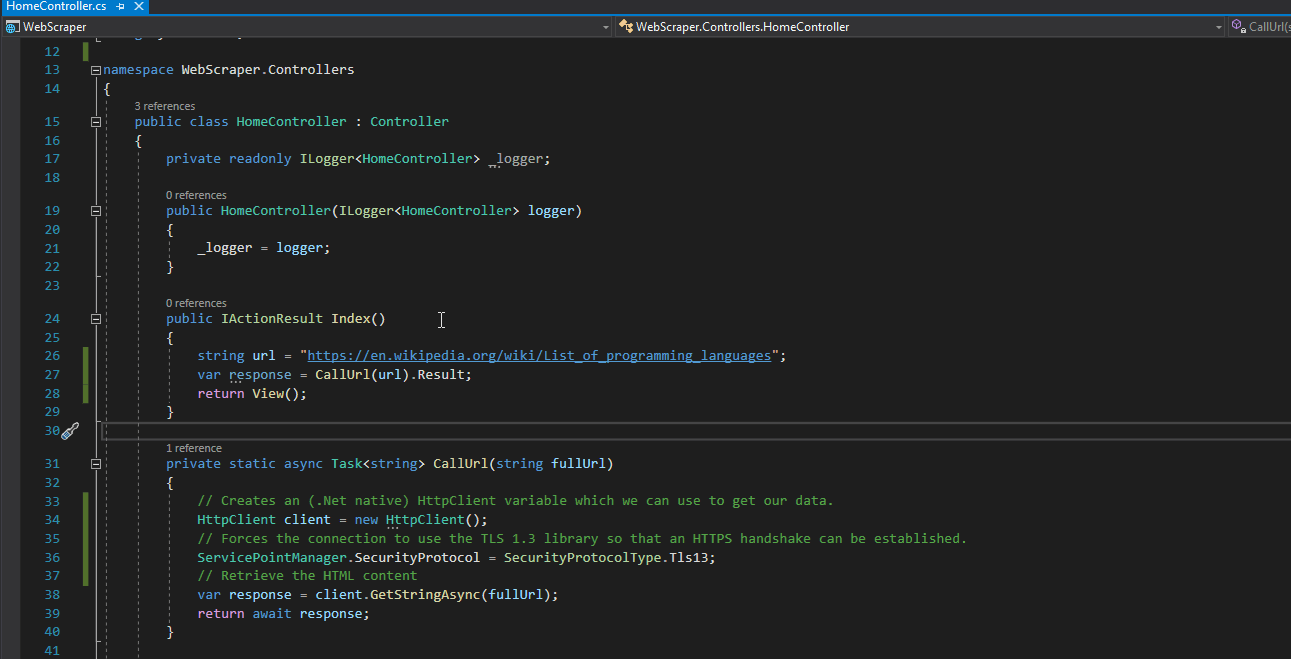\nLooks good! Now to parse the data.\n\n## Parsing the HTML\nThe first step in parsing the HTML is knowing what we’re looking for. For this exercise I’m happy with just getting all the individual programming languages held on the page. \nInspecting the programming names in the chrome dev tools shows us that each name is contained in an `` element. \n\n \nLet’s grab all the `` elements on the page and see what we get.\nFirst I’m going to create a new method to parse the HTML.\n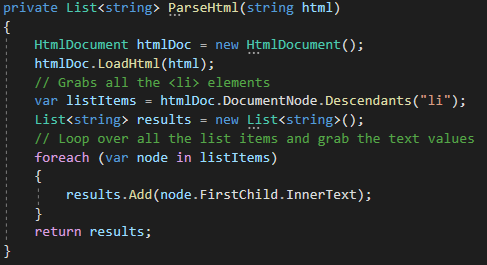\n \nWhile writing the method I used breakpoints to see the structure of the list items, the InnerText property appears to contain the data I want.\n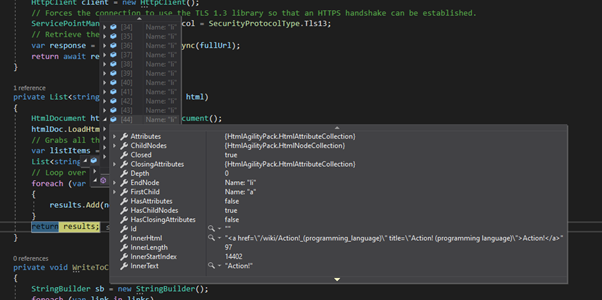\n \nThe problem with this approach is that there are a lot of other `` elements on the page and I’m getting their values as well, like this.\n\n \nBy poking around in the HTML source I was able to get values from the elements, or their parent nodes that I could start using to filter out some of the unwanted data.\n\n \nI didn’t sanitize the whole list since I don’t really have any plans for the data here, but you can see the method I used and see how that could be incorporated in your own code.\n\n## Saving the filtered data\nIt may be more convenient in your project to just save the data and do the sanitizing some other way after the fact. Since we’re keeping things simple lets just write a quick method to export this data to a .txt file.\n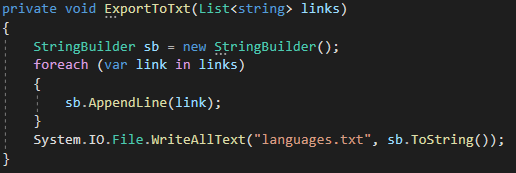\n\nAnd boom, here’s out output:\n\n \n## Conclusion\nWeb scraping is one of the various methods available to a developer who needs to make use of a web page’s content. In this article I covered a basic but powerful implementation, I hope to also cover scraping dynamically created webpages in the future.\n\nCheers!\n","path":"/posts/2022-05-18-scraping-static-web-pages"},{"date":"2022-05-17T14:30:00Z","layout":"post","title":"YakBit - making inclusion in the workplace matter","author":["Celina Bledowska"],"hero":"/static/images/pages/posts/2022-05-17-yakbit-making-inclusion-in-the-workplace-matter/hero.jpg","tags":["NorDev","NorDevCon","2022","Interview"],"excerpt":"Educator Mary-Jo Hill explains how YakBit can revolutionise workplace inclusion ahead of her conference speech. Having taught in education for 25 years and worked as an advisor, and then later as a leadership coach. Mary-Jo realised that many in the classroom have difficulty in h...","body":"\nEducator Mary-Jo Hill explains how YakBit can revolutionise workplace inclusion ahead of her conference speech.\n\nHaving taught in education for 25 years and worked as an advisor, and then later as a leadership coach. Mary-Jo realised that many in the classroom have difficulty in having their voices heard. She also acknowledged that adults in the workplace, during meetings and other events do not have the courage or encouragement to express their feelings and for sure, many voices shout louder and more frequently than others. Just take a look at Amanda Blanc’s recent meeting experience at Aviva!.\n\n## From school to work\n\n“YakBit evolved through my observation that, in a classroom, I needed to learn what is the best way to engage all in a teaching and listening forum, and how this can be managed to better effect.”\n\nHaving completed a MBA at the UEA, and taken part in the UEA Business Enterprise Start Up week, Mary-Jo decided that she wanted to use tech to analyse speech patterns and promote inclusivity in the workplace.\n\n## Tech to the rescue\n\nThose who feel marginalised and are less confident will benefit from YakBit. Research shows that there is a need to measure real time inclusion. This carries through from the educational environment right through to the workplace.\n\nBy using speech analytics, AI, and machine learning to increase awareness of how people talk and listen in a meeting space. Mary-Jo stresses that YakBit is still in its infancy but is examining ways to use insight to make meetings more effective. The AI will also be able to register silences as well as speech - who is speaking, who isn’t and then analysis can assess why this is so. The aim is to “ensure that there is core participation and there are structures and systems in place so those who are less confident become more engaged.”\n\n## Testing the methodology\n\nYakBit is now trialling the MVP with a creative agency in Norwich, with AI expertise on the Board. Smart Grant Funding for further R&D is vital to move this forward. By talking at the conference Mary-Jo hopes that members of the tech community will contribute, with their thoughts, ideas, expertise and knowledge.\n\n## The future\n\nCorporations who might wish to adopt YakBit, include those early adopters, “who value equality and inclusion.”’ She is also very aware that companies that, potentially, could benefit from this programme, will be nervous. On the positive side “many industries have a mandate to report on Equality, Diversity and Inclusion.” Mary-Jo values all Norfolk Networks and colleagues here to find companies interested in adopting YakBit.\n\n\n\n\n","path":"/posts/2022-05-17-yakbit-making-inclusion-in-the-workplace-matter"},{"date":"2022-05-15T17:12:00Z","layout":"post","title":"My personal surprises when learning to code. ","author":["Rich Saunders"],"tags":["Rich's Rambles","Getting Started","Passion","Advocacy"],"excerpt":"Having got into coding recently there have certainly been some surprises for me. Some of it had stemmed from how the code works Vs how I expected it to work. Some things seem counterintuitive until I dive and delve further into the why as well as the what and then it makes sense....","body":"\nHaving got into coding recently there have certainly been some surprises for me. \n\nSome of it had stemmed from how the code works Vs how I expected it to work. Some things seem counterintuitive until I dive and delve further into the why as well as the what and then it makes sense. \n\nOne of the surprises was the community and how friendly, helpful and supportive they are. I have always heard great things about coding communities but to see it and be on the receiving end has been different. I really see now how much of this is people's passion and it's so refreshing to see how excited people are to see others moving into their industry. \n\nMy biggest surprise though was how much I want to code! \n\nNow I want to code for a living, I never saw it as a hobby or general past time. It for me was a way to make a living doing something I enjoyed. I always saw people who lived, breathed and slept code. The kind who do it for work, have personal projects on the go, spend time helping others and contribute to open source works too. I always admired those people but I always thought \"these are people that live to work\" and I am someone who \"works to live\". \n\nHow wrong I was!\n\nThe more I code, the more I want to code. I find myself becoming more and more passionate about it the more I learn and the more I write. \n\nJust this week I almost cancelled two sets of plans because I just wanted to code or I was in the zone and didn't want to stop. Thankfully the voice in my head reminded me about balance in life so I closed the laptop and socialised like a good boy. \n\nWhat I'm getting at is;\n\n- I have discovered that you really can make a living out of something you love.\n- I now know how wonderful it is to be part of a community.\n- It's a great to have something to feel so passionate about.\n\nI just can't wait to get myself up to speed and contribute to some projects myself.\n","path":"/posts/2022-05-15-newbie-surprises"},{"date":"2022-05-13T16:00:00Z","layout":"post","title":"How smart phones have made the web dumb.","author":["Rich Saunders"],"tags":["Rich's Rambles","Web","Frontend"],"excerpt":"How smart phones have made the web dumb. Is it just me or has the modern web become, kind of boring? I have been fortunate enough to see the web evolve from its early days of finding it's feet with the public to the behemoth it is today. Over time it feels like we have gone full ...","body":"\n## How smart phones have made the web dumb.\n\nIs it just me or has the modern web become, kind of boring? I have been fortunate enough to see the web evolve from its early days of finding it's feet with the public to the behemoth it is today. Over time it feels like we have gone full circle. Websites started out simple and functional, then evolved some more depth with multiple pages, navigation and new UI. Eventually we got broadband that gave us internet speeds able to deliver bigger webpages, faster and as a result a boom of creativity in the industry of web design.\n\n### Where we started\nThe very first websites we as basic as they could be, pure function with little in the way of styling and imagery. Restricted by the capabilities of the browser, the languages and of course the speed of the internet. A copy of the [very first website](https://www.webdesignmuseum.org/web-design-history/tim-berners-lee-created-the-first-website-1991) is still available today. Even some of the most iconic websites had humble begins, just check out the original Amazon homepage from 1995.\n\n\n\nWebsites started to get a bit more styling and imagery over time but were still quite limited.\n### The implementation of broadband\nOnce broadband landed in the homes of UK residents back in 2000, thing started to change. We had more capabilities with the languages we used as well as being able to serve up more due to faster internet. \nWith this came a new wave of creativity in web design. We went from simple menus to wonderfully interactive sites like Supertotto.\n\n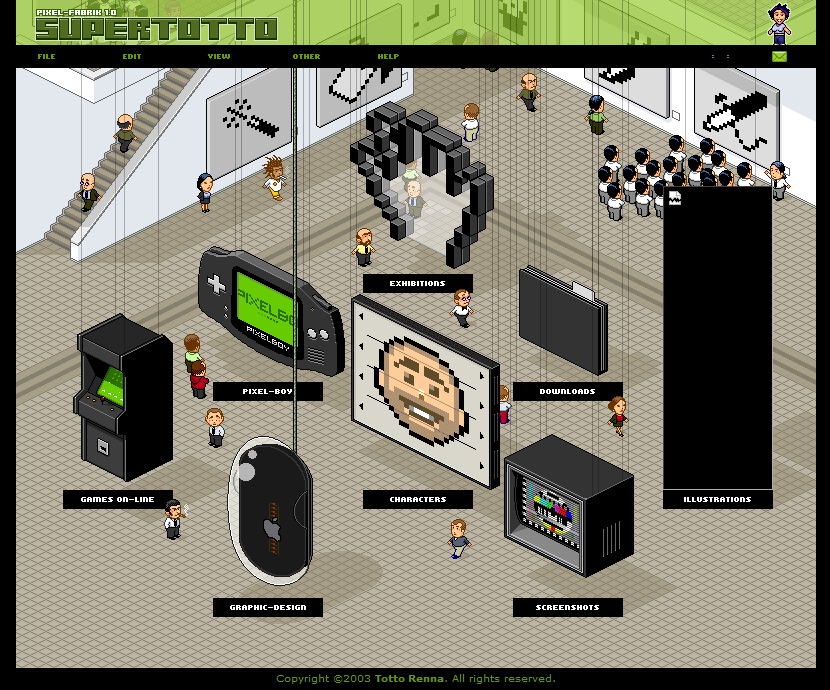\n\nOr maybe even Engine, another example of a creative UI.\n\n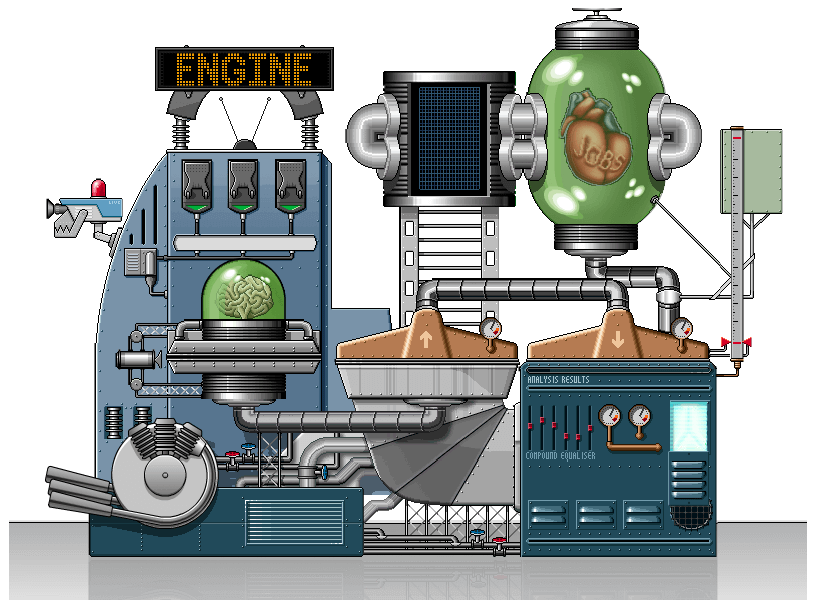\n\nIf you fancy a nostalgic trip down memory lane then you can find plenty more at the [Web Design Museum.](https://www.webdesignmuseum.org/gallery/creative)\n### Introducing the smartphone\nFast forward to the year 2007 and you will find the introduction of the iPhone. The worlds first successful smart phone. The sheer popularity of Smart Phones finally allowed users a way to browse the web with ease from their mobile phone and presented a new challenge for web design, how to make websites work well on such a small screen? Well the answer was simple, make a website designed for a small screen and designed to scroll. To start with most companies didn't have a mobile friendly website, nor were they ready to redesign the entire website to be mobile friendly and we ended up with two versions off the same site. Big companies simply re-directed the user to whichever website suited the medium they were using.\n### The demand for a clean UI\nSmall screens weren't the only challenge that was faced with the rise of the smartphone. The smartphone also changed how we interacted with websites, mostly influenced by how we had become accustom to easy-to-navigate nature of mobile apps. People no longer wanted websites full of links, graphics. Non-pertinent information often caused users to grow impatient and frustrated quickly. The days of the content driving the design of a website were out and the days of user focused design were in.\n### Simplistic page layout\nAs people started designing with mobile in mind and a lot of people started designing mobile first we saw a shift from three column websites to single column websites. Websites with a long, scrolling page of content. The competition was all about who could deliver the most information with the least links and most clarity as well as an elegance and simplicity to the design. Things became very clean.\n### Clean navigation\nSmall screens gave a want and need for cleaner and clearer navigation. Pressing a tiny text link with your thumb wasn't easy. App's introduced larger buttons and as we were already getting used to the streamlined look of app navigation we started to demand it from our websites too and in response we got it. It came in the form of hidden elements. On desktop, a navbar along the top of the page. On mobile, a navigation menu that popped up with the press of a button. Some modern websites now simply opt for nothing more than hidden navigation menu, further adding to the simple look of the modern web.\n### Flat design\nSmall screens with low resolution made it hard to see the details, shadows and gradients for example. Instead we started looking at bold, clear and punchy designs. It soon started finding it's way onto desktop as well. Long gone was the time of 3D designs and complex designs.\n### Where we are now\nNow? Now I feel we are in a place where the web has become boring. All of these changes may make it easier and simpler to navigate the web but it has also made it boring. It feels like a lot of creativity has been lost behind peoples expectations of how a service should work. For example, you walk into a supermarket, you expect a very similar look to their competitor. I will admit that a lot of things are making a comeback now that the resolution of smartphone has improved, we are seeing subtle shadows, gradients and more re-appearing but the interactivity and creativeness of websites is still lacking. Most websites nowadays look the same, same layout, same design, different branding and different colours but that's another article altogether. In conclusion the web has become basic again, and personally, I feel the smart phone has made the web dumb. \n","path":"/posts/2022-06-09-how-smartphones-shaped-the-modern-web"}],"total":69},"__N_SSG":true}